With recent storms forcing inhabitants of entire B.C. towns to evacuate at a moment's notice, knowing what goes into an emergency kit has become more relevant than ever.
The Province of BC has laid out detailed guidelines on what should be included in emergency kits designed for different scenarios.
Grab-and-go bag
The first emergency kit is specific to each person in a household in the event of a sudden need to evacuate. The bag should be stored near your front door where you can easily grab it on your way out.
The grab and go bag should include:
- Sleeping bag or blanket
- One set of all-season clothing
- Bottled water
- Snacks (enough to keep you going for 12 hours)
- Whistle
- Flashlight and batteries (or hand-crank light)
- Radio and batteries (or hand-crank radio)
- Extra batteries, phone charger and battery bank
- Small first-aid kit and personal medications
- Personal toiletries
- Extra pair of glasses or contact lenses
- Photocopies of your emergency plan, identification, insurance papers, and other important documents
- Cash in small bills
- Pen and notepad
- Sentimental or comforting items (for example photos, toys, etc)
Pet emergency kit
Like any other member of your family, pets should have their own grab-and-go bag set up too. The kit should be stocked with enough supplies to last your pet for at least 72 hours.
Your pet emergency kit should include:
- Vet and vaccination records in resealable plastic bags, including contact information for your veterinarian
- Up to two weeks' worth of medication, if needed
- Pet first aid kit
- Pet food (if you use wet food, make sure you have pop-up cans or a manual can opener)
- Water
- Non-spill food and water bowls
- Extra collar and leash
- Blankets, toys, treats
- Cage, carrier or kennel
- Paper towels, disinfectant, plastic bags for waste disposal
- Cat litter
Home kit
A home kit will help the entire family cope without services that may be lost in the event of a disaster. The major difference between a grab and go bag and a home kit is meant to be used at home where a grab and go bag is meant to be taken with you. As such the home kit can be a large container or duffle bag Supplies in the home kit should last at least 72 hours and up to one week.
The home kit should include:
- Water (four litres per person per day)
- Non-perishable food (dried, canned), or emergency food rations
- Manual can opener
- Spices and sweeteners (salt, pepper, honey, sugar)
- Durable cups, bowls, plates, and cutlery
- Tissues, toilet paper
- Personal hygiene supplies (soap, toothpaste, diapers)
- Garbage bags and wet wipes
- Dust masks
- Seasonal clothing, sturdy footwear
- Blankets
- Personal comforts (coffee, tea, teddy bear)
- Phone charger or battery bank
- Cash in small bills
- Help and OK signs
Vehicle emergency kit
As the name suggests, this kit is designed to keep you alive if you are in your vehicle when an emergency happens.
The vehicle emergency kit should include:
- Compass
- Road maps
- Fire extinguisher
- First aid kit
- Seat belt cutter
- Emergency food pack
- Flashlight and batteries
- Matches and a survival candle in a deep can (to warm hands and drinks)
- Survival blanket
- Extra clothing or footwear
- Ice scraper and brush
- Methyl hydrate (to de-ice fuel lines and windshields)
- Sand, salt, or cat litter (to help with traction in icy conditions)
- Shovel
- Traction mats
- Tow chain
- Booster cables
- Warning light or road flares
- Axe or hatchet
- Cloth or paper towels
Replace any expired items like food and batteries twice a year.




